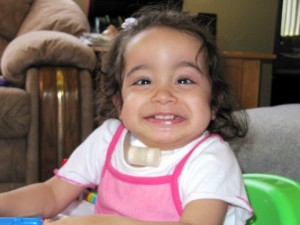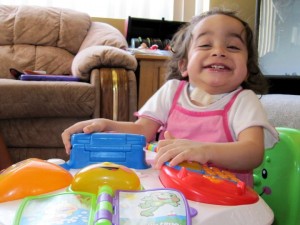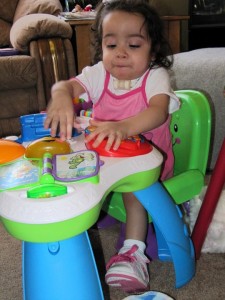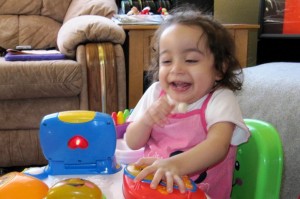Is It Time We Paid More Attention to Rare Diseases
http://www.time.com/time/health/article/0,8599,2012177,00.html
By FRANCES PERRAUDIN
 When Hannah Ostrea was five months old, she was diagnosed with Gaucher’s disease, a genetic condition in which the body lacks the enzyme needed to break down a fatty waste product called glucocerebroside, leaving it toaccumulate in the body’s organs. The disease is painful, with the excess glucocerebroside impairing mobility and delaying growth. Hannah’s form of the disease, Neuronopathic Gaucher’s disease, also causes brain damage and eye movement disorders and makes swallowing difficult. Neuronopathic Gaucher’s affects less than 1 in 100,000 live births and the life expectancy of a sufferer is between two and 20 years — Hannah is now two. But because the medical community won’t dedicate time or money to an illness that affects so few, there is no cure on the horizon. “Unless you have a celebrity who has a personal interest in your disease or you have a ‘popular’ rare disease … there are no big foundations, large fundraisers, or even any interest in assistance,” says Hannah’s mother Carrie. “It’s so hard knowing that there is so little research out there for my daughter, and that because of this, we will likely lose her sooner rather than later.”
When Hannah Ostrea was five months old, she was diagnosed with Gaucher’s disease, a genetic condition in which the body lacks the enzyme needed to break down a fatty waste product called glucocerebroside, leaving it toaccumulate in the body’s organs. The disease is painful, with the excess glucocerebroside impairing mobility and delaying growth. Hannah’s form of the disease, Neuronopathic Gaucher’s disease, also causes brain damage and eye movement disorders and makes swallowing difficult. Neuronopathic Gaucher’s affects less than 1 in 100,000 live births and the life expectancy of a sufferer is between two and 20 years — Hannah is now two. But because the medical community won’t dedicate time or money to an illness that affects so few, there is no cure on the horizon. “Unless you have a celebrity who has a personal interest in your disease or you have a ‘popular’ rare disease … there are no big foundations, large fundraisers, or even any interest in assistance,” says Hannah’s mother Carrie. “It’s so hard knowing that there is so little research out there for my daughter, and that because of this, we will likely lose her sooner rather than later.”
Everybody has heard of the world’s biggest killers: cancer, HIV, malaria. But what about Xeroderma pigmentosum, which causes sufferers to react violently to direct exposure to sunlight? Or Jeune Syndrome, a potentially fatal bone-growth disorder that restricts the expansion of organs. An estimated 250 million people worldwide suffer from rare diseases — the term for about 6,500 disorders, each of which, according to the official U.S. definition, affects fewer than 200,000 Americans. Around 8% of people will become afflicted with a rare disease at some point in their lives. Treating these diseases puts a burden on health services and living with them can destroy families — losing a loved one is a tragedy, no matter if it’s to cancer or Kawasaki disease, which causes the inflammation of the blood vessels. But because of the rarity of each condition, the number of patients in any one country is too small for experts to use for effective clinical research or raise significant awareness.(See how to prevent illness at any age.)
There have been efforts to address this problem before. The Orphan Drug Act passed in the U.S. in 1983, for example, gives tax incentives to companies that choose to develop such drugs, and grants them the right to sell the drugs without competition for seven years. But this is hardly a comprehensive fix. In the hopes of finally giving rare diseases the attention they deserve, Dr. Christopher Forrest of the University of Pennsylvania and colleagues from the Office of Rare Diseases Research at the National Institutes of Health recently put out a call for the establishment of a global rare-diseases registry. The idea would be to allow patients, clinicians and researchers who are scattered around the world to enter their own data on new therapies and practices, all in one place. The registry would also provide more accurate patient-population statistics, so that instead of trying to study a handful of sufferers in one country, scientists and drugs companies would have access to information from thousands of people affected by the same rare disorder, making it much easier to conduct research into their causes and cures. “Disease knows no boundaries,” Dr. Forrest tells TIME in an email. “Some rare diseases occur so infrequently that only by forming international populations can sufficient numbers of patients be accrued.”
Dr. Forrest says the registry’s primary goal would be to create an infrastructure to start tackling rare diseases — a necessary first step before trying to raise funding — and prod drug development. Persuading pharmaceutical companies to invest in developing orphan drugs has always been a struggle. Legislation similar to the 1983 U.S. law has been passed in the E.U., Australia and Japan. But developing new drugs can be expensive, and because rare diseases affect so few people, companies see little incentive in doing the necessary research
Recently, though, there have been signs that there could be money in orphan drugs. In early August, multi-national pharmaceutical company Sanofi-Aventis proposed a takeover of Genzyme, the world’s third-largest biotechnology company and specialist in orphan drugs. Sanofi reportedly offered $20 billion, but Genzyme is said to be unlikely to accept anything below $22 billion. The move shows that Big Pharma is beginning to see potential in a long-neglected market. “The rare disease market can be profitable in and of itself,” says Gary Pisano, a biotechnology industry expert at Harvard Business School. “Genzyme proved this. They were the first to recognize the commercial potential of these markets that had long been ignored because of the apparently small size.”
That sounds like good news for rare-disease sufferers. Still, the fact is that profits from orphan drugs are high partly due to the astronomical prices companies can demand for their treatments — with little or no competition, there’s no reason for them to keep prices down. Hannah’s parents rely on Cerezyme, Genzyme’s Gaucher disease drug, to treat their daughter’s illness. Costing more than $200,000 for a year’s supply, it is one of the most expensive drugs in the world and last year generated sales of $1.2 billion for Genzyme. With Carrie’s husband unemployed since February and Carrie having to stay home to look after Hannah, they are burning through their savings to pay for the medication. Billion-dollar deals are no help to them. But if the rare-diseases registry becomes a reality, that could be a big step towards tackling disorders that are devastating for the few who suffer from them. “Deep down I wish the general public would just recognize what families like ours live through on a daily basis,” Carries says. “And how rare disease affects each and everyone one of us down to the core.”





Latest Comments